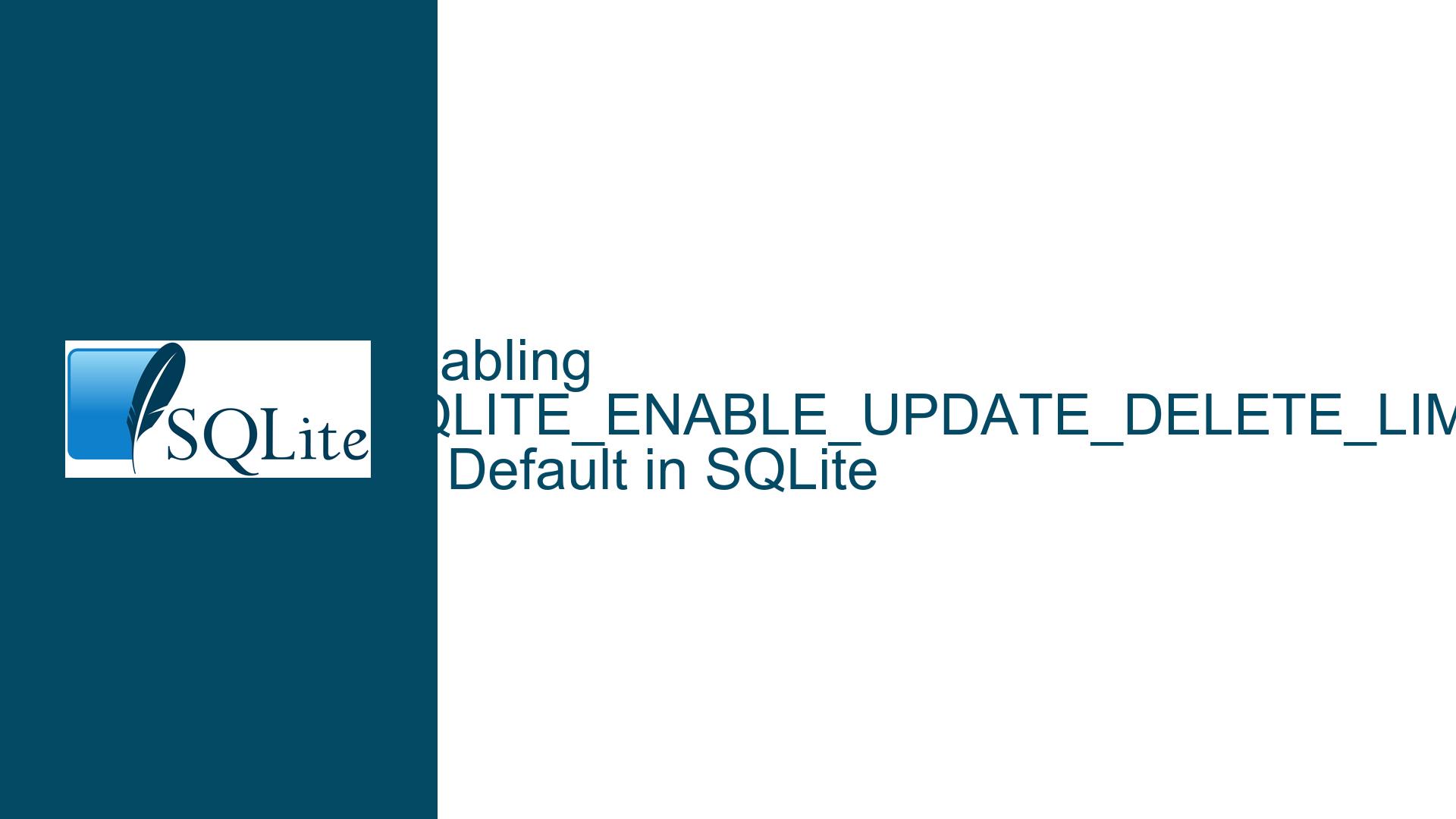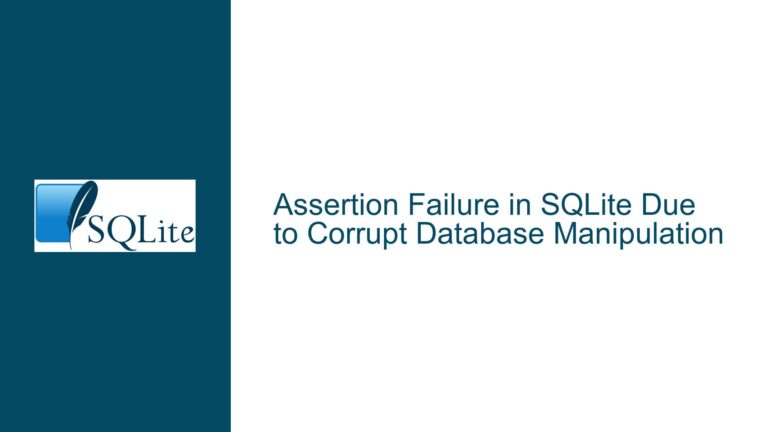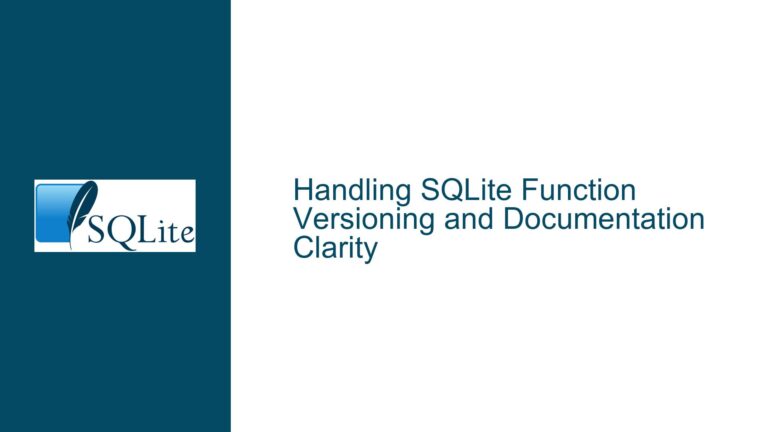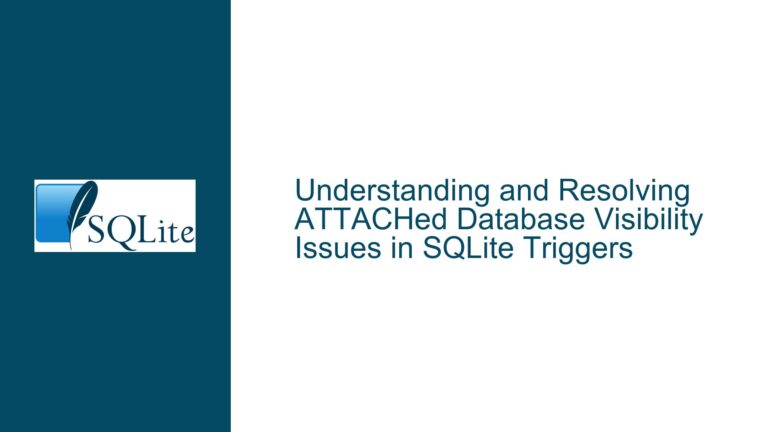Enabling SQLITE_ENABLE_UPDATE_DELETE_LIMIT by Default in SQLite
SQLite’s LIMIT Clause on DELETE and UPDATE: A Feature Overview
SQLite is a powerful, lightweight, and widely-used relational database management system. One of its notable features is the ability to use the LIMIT clause with DELETE and UPDATE statements, which allows developers to control the number of rows affected by these operations. This feature is particularly useful in scenarios where you want to bound the amount of work done in a single transaction, ensuring that the database remains responsive and that transactions do not grow too large.
The LIMIT clause on DELETE and UPDATE statements is not enabled by default in SQLite. Instead, it requires the SQLITE_ENABLE_UPDATE_DELETE_LIMIT compile-time option to be enabled when building SQLite from source. This option must be defined during the compilation process, and it is not included in the default amalgamation builds available on the SQLite website. This has led to confusion and frustration among developers who expect this feature to be available out-of-the-box, especially given the introduction of the RETURNING clause in SQLite 3.35, which synergizes well with LIMIT on DELETE and UPDATE.
The RETURNING clause allows developers to retrieve the rows affected by a DELETE or UPDATE operation in a single query, simplifying code that would otherwise require multiple steps. For example, instead of first selecting rows to delete and then deleting them in a separate operation, developers can now delete rows and retrieve the deleted data in one go. However, without the LIMIT clause on DELETE and UPDATE, this pattern cannot be fully utilized in scenarios where bounding the number of affected rows is necessary.
The absence of LIMIT on DELETE and UPDATE in the default SQLite builds has raised questions about why this feature is not enabled by default. The primary reason appears to be related to code size and execution time. Enabling SQLITE_ENABLE_UPDATE_DELETE_LIMIT increases the size of the SQLite binary, albeit marginally, and introduces additional execution branches that could potentially impact performance. However, the actual impact on code size is minimal, with the feature adding only a few kilobytes to the binary. This has led to a debate about whether the benefits of enabling this feature by default outweigh the costs, especially given that most users are unlikely to be operating in environments where such small increases in code size are critical.
The Impact of SQLITE_ENABLE_UPDATE_DELETE_LIMIT on Code Size and Performance
The SQLITE_ENABLE_UPDATE_DELETE_LIMIT option, when enabled, allows SQLite to support the LIMIT clause on DELETE and UPDATE statements. This feature is particularly useful in scenarios where developers need to control the number of rows affected by these operations, such as when processing large datasets in smaller, more manageable chunks. However, enabling this feature comes with some trade-offs, primarily related to code size and execution time.
When SQLITE_ENABLE_UPDATE_DELETE_LIMIT is enabled, the SQLite binary grows slightly in size. For example, enabling this option in SQLite 3.35.0 adds approximately 6,032 bytes to the shared library (libsqlite3.so) and 19,768 bytes to the static library (libsqlite3.a). While these increases are relatively small (0.15% and 0.21% respectively), they can be significant in environments where minimizing code size is critical, such as embedded systems or resource-constrained devices.
In addition to the increase in code size, enabling SQLITE_ENABLE_UPDATE_DELETE_LIMIT introduces additional execution branches in the SQLite code. These branches are necessary to handle the LIMIT clause on DELETE and UPDATE statements, but they can potentially impact performance, especially in scenarios where these operations are performed frequently. However, the actual performance impact is likely to be minimal for most applications, as the additional branches are only executed when the LIMIT clause is used.
Despite these trade-offs, the benefits of enabling SQLITE_ENABLE_UPDATE_DELETE_LIMIT by default are significant. The feature allows developers to write more concise and expressive code, particularly when combined with the RETURNING clause. For example, instead of writing separate SELECT and DELETE statements to retrieve and delete rows, developers can now perform these operations in a single query, reducing the complexity of their code and potentially improving performance by reducing the number of database round-trips.
Moreover, the increase in code size is relatively small, and the performance impact is likely to be negligible for most applications. Given that most users are unlikely to be operating in environments where such small increases in code size are critical, it seems reasonable to enable this feature by default, allowing developers to take full advantage of SQLite’s capabilities without having to manually enable compile-time options.
Enabling SQLITE_ENABLE_UPDATE_DELETE_LIMIT: A Step-by-Step Guide
Enabling the SQLITE_ENABLE_UPDATE_DELETE_LIMIT option in SQLite requires building the library from source with the appropriate compile-time options. This section provides a detailed guide on how to enable this feature, along with some considerations for developers who may be concerned about the impact on code size and performance.
Step 1: Download the SQLite Source Code
The first step in enabling SQLITE_ENABLE_UPDATE_DELETE_LIMIT is to download the SQLite source code. The source code can be obtained from the official SQLite website, which provides both the amalgamation and the full source distribution. The amalgamation is a single file that contains the entire SQLite library, making it easier to compile and integrate into other projects.
Step 2: Modify the Compile-Time Options
Once the source code has been downloaded, the next step is to modify the compile-time options to enable SQLITE_ENABLE_UPDATE_DELETE_LIMIT. This can be done by adding the following line to the sqlite3.c file:
#define SQLITE_ENABLE_UPDATE_DELETE_LIMIT 1
This line should be added near the top of the file, before any other #define statements. Alternatively, the option can be passed to the compiler using the -D flag:
gcc -DSQLITE_ENABLE_UPDATE_DELETE_LIMIT=1 -o sqlite3 sqlite3.c
Step 3: Compile the SQLite Library
After modifying the compile-time options, the next step is to compile the SQLite library. This can be done using a standard C compiler, such as GCC or Clang. The exact command will depend on the platform and the desired output format (e.g., shared library, static library, or executable).
For example, to compile SQLite as a shared library on a Unix-like system, the following command can be used:
gcc -DSQLITE_ENABLE_UPDATE_DELETE_LIMIT=1 -shared -o libsqlite3.so sqlite3.c
To compile SQLite as a static library, the following command can be used:
gcc -DSQLITE_ENABLE_UPDATE_DELETE_LIMIT=1 -c sqlite3.c
ar rcs libsqlite3.a sqlite3.o
Step 4: Verify the Feature is Enabled
Once the SQLite library has been compiled, the next step is to verify that the LIMIT clause on DELETE and UPDATE statements is enabled. This can be done by running the SQLite shell and executing a test query:
sqlite> CREATE TABLE foo (id INTEGER);
sqlite> INSERT INTO foo VALUES (1), (2), (3);
sqlite> DELETE FROM foo LIMIT 1;
sqlite> SELECT * FROM foo;
If the LIMIT clause on DELETE is enabled, the query should execute successfully, and only one row should be deleted from the foo table. If the feature is not enabled, an error will be returned indicating that the LIMIT clause is not supported.
Step 5: Integrate the Custom SQLite Library
The final step is to integrate the custom SQLite library into your application. This will depend on the specific programming language and environment you are using. For example, if you are using Python with the sqlite3 module, you can replace the default SQLite library with your custom build by setting the LD_LIBRARY_PATH environment variable:
export LD_LIBRARY_PATH=/path/to/custom/sqlite:$LD_LIBRARY_PATH
python3 my_application.py
Alternatively, if you are using a language binding that allows you to specify the path to the SQLite library, you can do so directly in your code. For example, in Python, you can use the ctypes module to load the custom SQLite library:
import ctypes
import sqlite3
# Load the custom SQLite library
ctypes.CDLL('/path/to/custom/sqlite/libsqlite3.so')
# Use the sqlite3 module as usual
conn = sqlite3.connect(':memory:')
cursor = conn.cursor()
cursor.execute('CREATE TABLE foo (id INTEGER)')
cursor.execute('INSERT INTO foo VALUES (1), (2), (3)')
cursor.execute('DELETE FROM foo LIMIT 1')
print(cursor.execute('SELECT * FROM foo').fetchall())
Considerations for Code Size and Performance
While enabling SQLITE_ENABLE_UPDATE_DELETE_LIMIT provides significant benefits in terms of code simplicity and expressiveness, it is important to consider the impact on code size and performance, especially in resource-constrained environments. As mentioned earlier, enabling this option increases the size of the SQLite binary by a small amount, and introduces additional execution branches that could potentially impact performance.
However, the actual impact on code size is minimal, with the feature adding only a few kilobytes to the binary. For most applications, this increase is unlikely to be significant, and the benefits of enabling the feature by default outweigh the costs. Moreover, the performance impact is likely to be negligible for most applications, as the additional branches are only executed when the LIMIT clause is used.
For developers who are concerned about code size, there are several strategies that can be used to minimize the impact. For example, using compiler optimizations such as -Os (optimize for size) can reduce the size of the binary, and stripping the binary can further reduce its size. Additionally, developers can selectively enable or disable other SQLite features to achieve the desired balance between functionality and code size.
Conclusion
Enabling SQLITE_ENABLE_UPDATE_DELETE_LIMIT in SQLite provides significant benefits in terms of code simplicity and expressiveness, particularly when combined with the RETURNING clause. While there are some trade-offs in terms of code size and performance, the actual impact is minimal for most applications, and the benefits of enabling this feature by default outweigh the costs.
By following the steps outlined in this guide, developers can enable SQLITE_ENABLE_UPDATE_DELETE_LIMIT in their custom SQLite builds, allowing them to take full advantage of this powerful feature. Whether you are working on a large-scale application or a resource-constrained embedded system, enabling this feature can help you write more concise and efficient code, improving both the readability and maintainability of your database operations.






